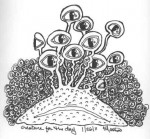
The 2011 awards were announced earlier this month. http://www.ala.org/ Award winners Winner: A Sick Day for Amos McGee illustrated by Erin E. Stead, written by Philip C. Stead, and is a Neal Porter Book, published by Roaring Brook Press, a division of Holtzbrinck Publishing Honor Books: Dave the Potter: Artist, Poet Slave illustrated by Bryan Collier, written by Laban Carrick Hill and published by Little, Brown and Company, a division of Hachette Book Group, Inc. and Interrupting Chicken written and illustrated by David Ezra Stein, and published by Candlewick Press. Sadly, I have yet to see any of these books.
Last year’s books for 2010 Randolph Caldecott Medal are the winner: The Lion & the Mouse , illustrated and written by Jerry Pinkney (Little, Brown and Company Books for Young Readers) The screech of an owl, the squeak of a mouse and the roar of a lion transport readers to the Serengeti plains for this virtually wordless retelling of Aesop’s classic fable. In glowing colors, Pinkney’s textured watercolor illustrations masterfully portray the relationship between two very unlikely friends. And the two honor books: All the World , illustrated by Marla Frazee, written by Liz Garton Scanlon, published by Beach Lane Books. Frazee’s small vignettes and sweeping double-page spreads invite readers to share a joyful day with a diverse, multigenerational community. Flowing lines and harmonious colors give vibrant life to Scanlon’s poetic text; and Red Sings from Treetops: A Year in Colors, illustrated by Pamela Zagarenski, written by Joyce Sidman, published by Houghton Mifflin Books for Children, Houghton Mifflin Harcourt. Zagarenski’s playful illustrations enliven Sidman’s expressive poetry in this exploration of the seasons and their colors. Computer illustration and mixed-media paintings on wood combine rich textures, intriguing graphic elements, stunning colors and stylized figures to reward attentive readers with a visually exciting interplay of poetry and illustration.
What makes these books better than the hundreds of other picture books published in 2010? (To see the criteria and focus of the Caldecott Award go to the ALSC web site: http://www.ala.org/ala/mgrps/divs/alsc/awardsgrants/bookmedia/caldecottmedal/caldecottterms/caldecottterms.cfm.) The honor of these awards is for an illustrator of merit.
I have been a huge fan of Marla Frazee (the illustrator for one of the honor books) for many years. Her style is one of deceptive simplicity. Something I have worked toward emulating in my own very complicated style. I know from experience, such stunning work is neither simple nor easy. The 2010 winning book has few words, and the art itself is breathtaking. I’m sure the artist spent a great deal of time working out all the myriad details needed to tell a wordless story. I’m not familiar with the third book, so can’t comment.
In my travels around the internet, there seems to be a consensus that the winners for this award seem to follow a trend of multiculturalism and education. From what I can observe in this year’s winners, such a statement appears to be holding true. Does that mean an illustrator should strive to create a multicultural world in his or her work? Since I do this in my books as a matter of course, it’s hard for me to say if all illustrators should. I know my practice comes from the years I spent in advertising where we had to have a cross section of humanity in the work we were producing. In me, such behavior has become an ingrained habit.
According to the Crafty Writer (http://www.thecraftywriter.com/2007/08/15/what-makes-a-good-childrens-book/) a good picture book has many of the same elements as any good book. A well crafted, original story that keeps the intended reader in mind. The difference in picture books, is of course, the illustrations. Because the two parts make up the whole, they have to be excellent on their own. Bad writing will kill a story no matter how beautiful the illustrations are. The inverse is also true. Mediocre illustrations just can’t be carried by the text. This is even more of an issue now when picture book texts have declined in length to a mere few hundred words. The illustrations must carry their own weight in the story telling arena.
The Through the Tollbooth blog (http://community.livejournal.com/thru_the_booth/35438.html) states that it is easier to say what a good picture book is by listing what it is not: boring, maudlin, preachy, flat, confusing, or long-winded. Lots of new writers think they need to create books that teach morals. Kids know when they are being preached at, and they don’t like it. Such a book will fall flat before it ever has a chance to make it to market. There is no need to explain why a book needs to avoid being boring. Nobody likes being bored. Since a picture book is most often read to the child, the story has to be entertaining and engaging for both the adult and the youngster.
On the Teach with Picture Books’ web site (http://teachwithpicturebooks.blogspot.com/2010/04/what-makes-good-picture-book.html) we’re told that a picture book must have a universal theme which can cross boundaries of culture, age and gender. Plus, the book must create its own world in which the young reader feels welcome no matter how outlandish or unusual the setting.
That’s an awful lot of requirements to fit into a 32 page book. Can you think of recent books that fall into the ‘good’ book category? Leave a comment and tell us about them and why you think they are good examples.

 RSS - Posts
RSS - Posts